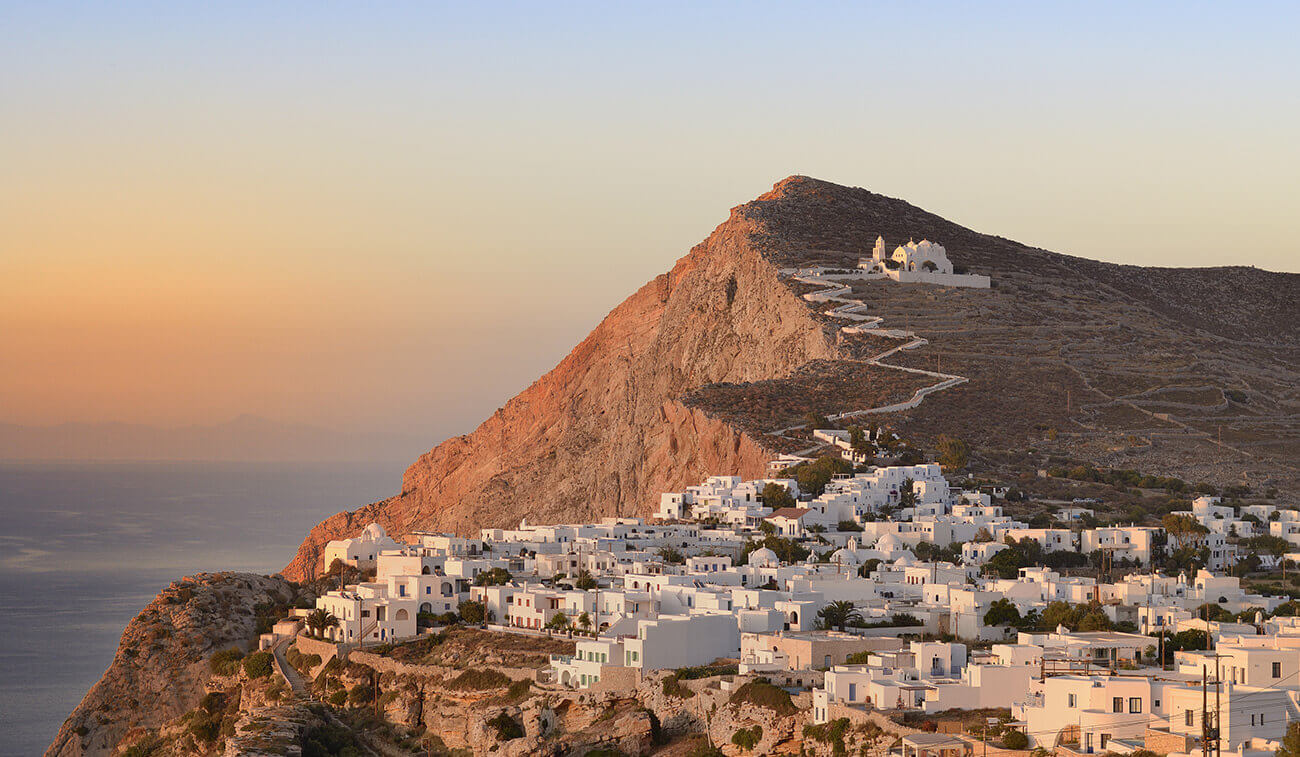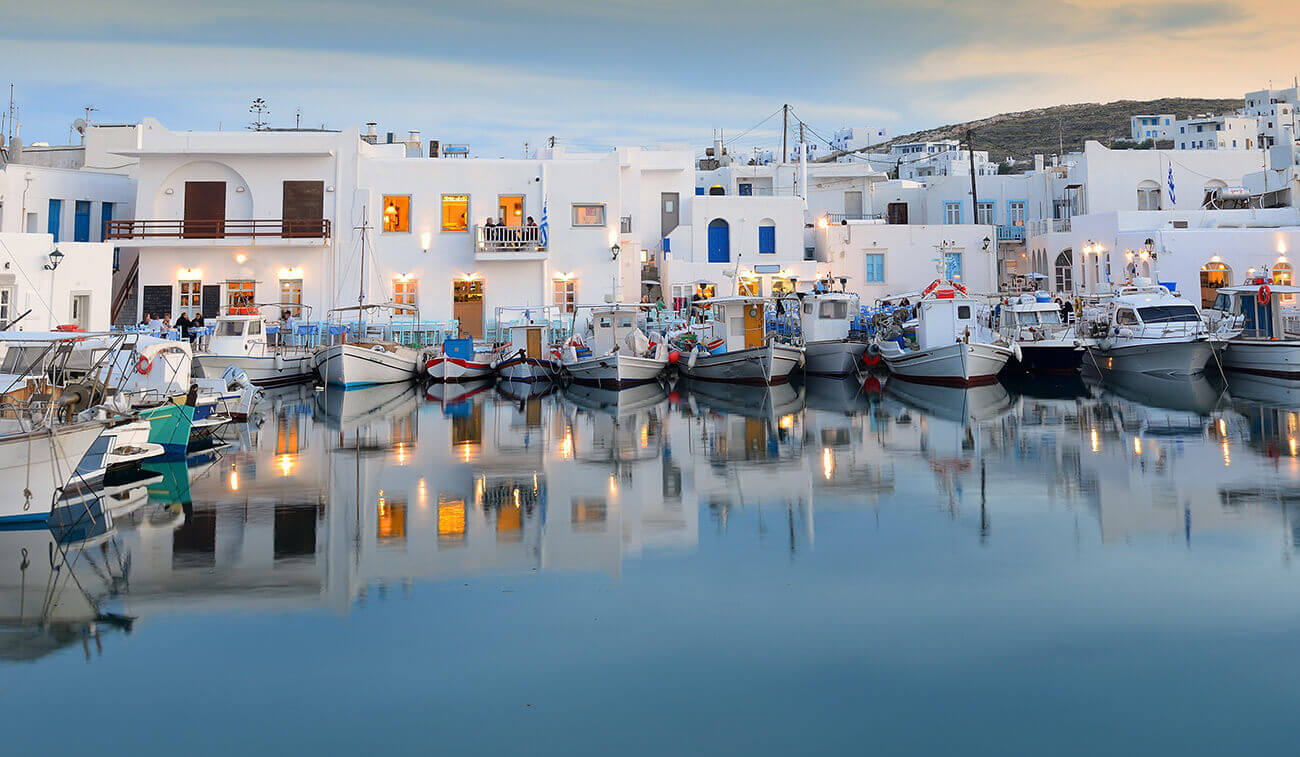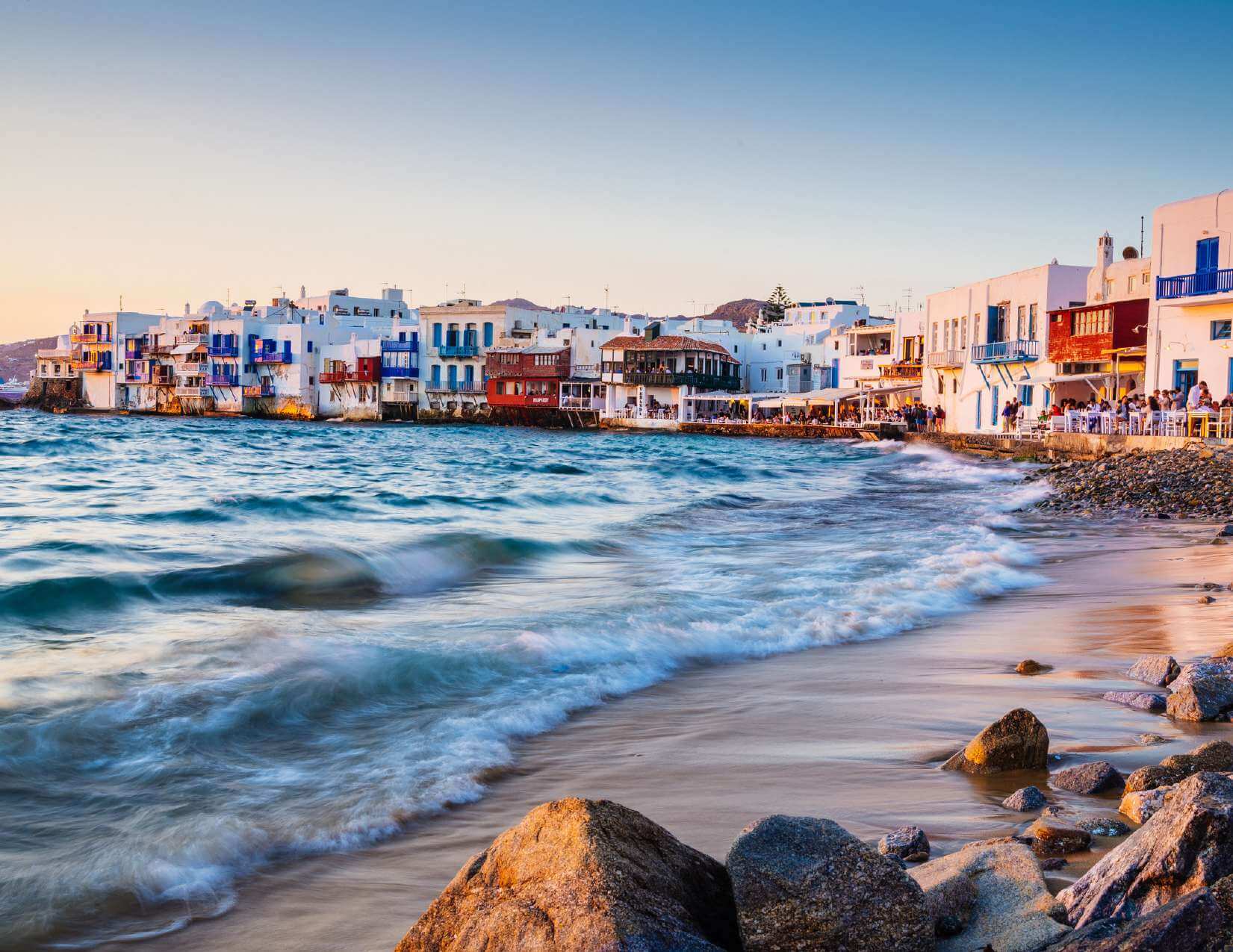SERIFOS ISLAND
Serifos, with its rugged mining sites, ladened with history, has its own distinct Cycladic flair. The island exudes a calm atmosphere and speaks directly to your senses. Despite its arid and wild land characteristics, Serifos is gracefully embraced by the deep blue colors of the Aegean Sea and has some magnificent beaches. The locals have respected the Cycladic architectural tradition by building white and blue houses making the islands towns and villages all the more wonderful.
Chora town is built amphitheatrically on a rocky hill commanding the island from the top. It is one of the most elegant Cycladic towns that will inspire you, even before the ship docks, on your arrival to Serifos. You’ll get to visit two neighborhoods; Pano (meaning upper) Chora and Kato (meaning lower) Chora connected by a stairway. You’ll find some bars, cafés and tavernas in the town’s narrow streets blending in with the whole scene harmoniously. It is worth taking a 10 minutes walk up to the Venetian castle, built in the 15th century, to drink in the view of the blue sea! An ideal place for taking a stroll or making a stop by the nearby cafés, fish tavernas and pastry shops located next to the seashore is the Serifos main Port, also know as Livadi. This area has a beautiful sandy beach
but is also very close to Avlomonas and Livadakia beaches.
Serifos’ cuisine bursts with aromas and flavors! On your vacation here don’t miss: delicious meat products such as louzes, syglina (traditional cured pork) and sausages, as well as the islands rich aromatic spices. Taste marathopites and marathotiganites (fennel pies baked or fried), revythada (traditionally cooked chickpeas) with a local variety of raisins,sun-dried octopus, local cheeses such as myzithres and xinomyzithres. Make sure to accompany your meal with the islands local wines. If you have a sweet tooth then try pasteli (sesame bar) which is cut in a diamond shape, with an almond in its middle and usually laid down on a lemon leaf as well as their delicious sweet wines.
FOLEGANDROS ISLAND
Shining under the Aegean sun, Folegandros was named after the son of king Minos. This off-the-beaten-path destination captivates the visitors with the untouched beauty of its beaches, the luminous blue of its waters, and the unadulterated style of its architecture.
At 200m above sea level travelers will discover Kastro, a Venetian castle. Chora, the capital town of the island, it's been built partially in it. Bougainvillea leaning over the balconies, sugar-cube whitewashed houses, and sheer cliff drops convey the island’s ethereal, yet wild, beauty.
Walk along the cobblestone narrow streets of Chora past white houses with multi-colored doors and windows, timeless creations of the traditional Cycladic architecture. If you need to take a rest, plane trees will offer you their cool, welcome shade. Wait until the sun sets into the eternal blue of the Aegean and join the locals in the village’s squares.
This small island in Cyclades is full of pebbly beaches covered with tamarisk trees. The scenic harbor of Karavostássis with its beautiful beach is the perfect starting point for an exploration of the glorious beaches of Hohlidia, Vitzetzo, Latinaki, Pountaki and Livadaki, a village with a sandy beach, turquoise waters and a camping site. Those of you, who don't feel like walking, can take a caique from Karavostássis to Kátergo, the most beautiful beach on the island, with thin pebbles and crystal-clear waters. Sheer cliff drops and azure waters embrace Agali beach to the west of the island.
SANTORINI ISLAND
Santorini is worthily considered one of the most famous and highly desirable destinations on earth. Just think that, apart from the usual pictures, there is an entire island of beauty, incredible beaches, sights and attractions, more than enough to make Santorini a famous destination. The fascinating legend of the island that emerged out of the lathered sea - an island cut into two, the globally unique archaeological riches, the sublime folk architecture and the magic that no picture can capture make Santorini an island of surprises which reveals its true face when summer visitors are gone, out in the open sea.
Santorini or Thera is at the far south of the Cyclades, together with Anafi. It covers an area of 73 square kilometers, in a circular arrangement together with Therasia and Aspronisi. In the center of this circle is the caldera created after the major volcanic eruption in 1650 BC. Inside the caldera, underwater eruptions caused the emergence of the isles of Palea Kameni and Nea Kameni - a unique phenomenon in the entire world. The view as the yacht approaches the island is breathtaking! A steep reddish-black rock of 300 meters, the caldera walls, stands imposing. And as the yacht approaches, human presence can be discerned - small houses and blue church domes - an impressive sight! Don't miss the chance to walk the route Fira - Firostefani - lmerovigli - Oia. The view to the caldera is unique in the world.
The beaches of Santorini, with their characteristic black or reddish sand, are charming in a special way: Exo Gialos, the Red and the White beach, Mesa Pigadia with the unique cave, Vlychada with the yellowish weathered rocks that form small caves and natural sculptures - a magnificent scenery! The settlement of Kamari features a very long beach and Perissa an endless beach of black sand and dark blue waters. Perissa is also the settlement where the largest church of Santorini, Timios Stavros (19th century) is located. In Pon, one can admire the large church of Panagia Kalou (1650) and enjoy swimming at a remote sandy beach.
IOS ISLAND
Íos or Niós, as the locals call it, is one of the most beautiful islands of the Cyclades, like a flower, as its name “Ion” denotes. According to the ancient tradition, Íos was the homeland of Homer’s mother and the final resting place of the great epic poet. Upon reaching the island, the view before you is enchanting: as pretty as a picture, Chora lies very close to the harbor in Ormos and greets the travelers, built in an amphitheater -like manner on the slope of a hill, on the top of which there are ruins of a medieval castle. This is a listed traditional village, one of the finest examples of Cycladic architecture.
Snow-white little houses, picturesque arcade-covered alleys (“stiyádia”), the twelve windmills, churches with arched belfries and light blue domes create a unique residential area. Chora’s sheltered alleys is the “stage” where Koúnia, an ancient local custom is performed every May, as follows: young men make swings for young ladies who rock themselves while listening to traditional love songs being sung to them in the form of a dialogue.
Ios offers many activities, including hiking, watching the amazing sunsets, visiting historic sites, and enjoying the laid-back lifestyle of Greece. For those who love hiking Ios is the ideal destination. Its hilly morphology and the innumerable paths opened by shepherds on its hills enable visitors to see amazing places of wild beauty and enjoy the view to the nearby islands. If you want to experience daily farming works performed in the old fashioned way, local stock farmers wit be willing to show you through the entire production process (grazing, milking, cheese-making).
Explore! Mylopótas, Magganári, Psáthi, Yialós, Kálamos and Ayia Theodóti beaches are known worldwide –among others– to be top choices for dives in the island’s emerald waters. In order to explore the inland, follow the paths that shepherds prefer to take (Ayia Theodóti- Hóra, Ayia Eirini-Valmás Beach, Hóra-Pýrgos-Psáthi, Hóra -Ayios Spyridonas-Perivólia-Ayios Prókopas-Pelekaniá) and discover the pristine natural beauty of Íos through magic scents and colours.
PAROS ISLAND
Paros is so fascinating on so many levels that many people love it having seen only one of its faces. Don't jump to conclusions about what you like, get to know the island first and find your "own" Paros, the face that suits you best. No doubt, though, it will charm you even if you see a different side from the one expected.
The island of Paros is famous for its golden beaches, clear blue waters and nightlife. However, it has much more than that to offer visitors, who will see a different island, offering many alternatives: its rich natural resources, the fascinating cultural heritage, the unique customs, the original traditional dishes and the famous wine, are some of the island's secrets that make visitors return.
Parikia, the capital of Paros, is a beautiful Cycladic village with whitewashed cubic houses and impressive neoclassical mansions. A well preserved 13th century Venetian castle stands proudly on a hill at the center of the village offering an amazing view of Parikia.
Wander through beautiful traditional villages like Naousa, a colorful village, where the ruins of a Venetian fortress stand at the entrance to its small harbor. Lefkes is located at the highest point of Paros and enjoys stunning views of the island. The village is set up in the mountains
and is surrounded by a rich green landscape. It has very well preserved Cycladic and neoclassical buildings, beautiful squares and narrow marble alleys.
Paros offers quality facilities to practice windsurfing, kite surfing, diving, horse riding and trekking. The island has several diving schools (the beaches Chrysi Akti, Santa Maria, and Pounta are ideal for diving). Pounta is the best beach for kite surfing, while the favorite beaches for windsurfing are Tserdakia, Chrysi Akti, Santa Maria and Pounta. The island also has surfing clubs. Amateur fishermen will find ideal spots on the coasts of Paros.
MYKONOS ISLAND
Mykonos is a wonderful Cycladic island, worth visiting at any time of the year. However, it is a must to enjoy the days of its summer glory, when it literally becomes an international village, when its community of believers make it a sight worth seeing, when one can experience the unique feeling that everything and everyone is in Mykonos.
According to mythology, Mykonos was formed from the petrified bodies of giants killed by Hercules. And did you know that the island took its name from the grandson of Apollo, “Mykonos”?
Set out on a journey to discover a fascinating world where glamour meets simplicity. On Mykonos celebrities, college students and families mingle together to celebrate the Greek summer. However, despite its cosmopolitan character, Mykonos remains a beautiful and picturesque island, whose all white Chora lies next to the sea, with golden beaches, friendly and smiling people and a continuous link with history lasting for centuries. If you think you've seen someone that looks famous, then you're probably right. In Mykonos you'll sit right next to famous actors, singers, stars, TV personalities, top models.
In Mykonos there are beaches that cater for all tastes: family beaches such as Lia, trendy beaches like Psarou and quiet beaches such as Agios Sostis.
In contrast to other Cycladic capitals, the capital town (Chora) of the island is not built in the shape of an amphitheater but instead spreads out over a wide area. It is one of the best examples of Cycladic architecture and a spellbinding attraction for visitors. Stroll around its narrow marble streets and admire whitewashed houses with colorful doors and window frames, bougainvillea trees in purple bloom and hidden churches.
KEA ISLAND
Due to its proximity to Athens, Kea (also called “Tzia”) is an easily accessible beauty with a scenery variety: steep mountains, small fields, olive groves, vineyards, valleys, picturesque coves, exciting hiking trails and off-the-beaten-track beaches. On the island with the largest oak forest in the Cyclades birdwatching is a real delight. For those who are into geology, there are plenty of small caves (like in Kálamos and in Áyios Timótheos). 36 km long cobbled trails will lead you to the four city-states of the ancient times: Ioulis, Karthaia, Koressia, Poiessa).
Situated in the centre of the island, at the site of the ancient citystate by the same name, the capital of Kea, Ioulis, is a very picturesque town with ceramic-tile roofed houses, cobbled streets, arched passages, steps and squares. The island was named after Ceos, a hero from Nafpaktos who settled on the island in the 12th century BC. The island was later named Tzia during the Venetian occupation. Kea played an important role in the flourishing of the Cycladic civilization and was homeland to great figures of ancient Greece, such as the poet Simonides.
For hikers, Kea is a paradise. Paths with a total length of 36 kilometres, 65% of which are stone-paved, cross dreamy routes through dense forests of tall oaks and lead to beautiful isolated beaches.









